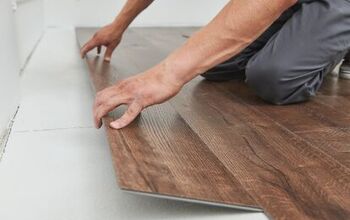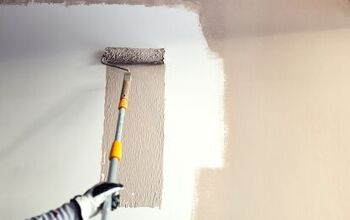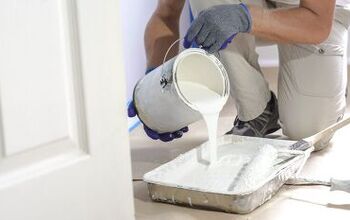Can You Paint Tile Floors?

Updating your home’s tile flooring can cost a pretty penny, even if you can lay your new floor over existing tile. On top of the costs of the new floors, you also have to pay for installation. If your tile floor is in good shape, painting tile floors can give you the fresh look you want.
You can paint tile floors using specialty paint designed specifically for tile applications using a paint roller. Oil-based paints hold up better, but high-gloss latex is another good option. Clean, sand, and prep the tiles before applying paint. Start with a primer and end with a sealer to get the best finish. Allow your tile floors to dry for at least 24 hours.
According to Home Advisor, installing new tile floors costs between $3 and $30 per square foot. Therefore, painting can save you a ton of money, and it’s easy to tackle yourself as a weekend project.
Seven Simple Steps For Painting Tile Floors
The key to getting a professional look when you paint tile floors is to follow the proper steps. Don’t take shortcuts, especially with your prep work.
1. Gather Your Supplies
Before you begin, make sure you have everything you need.
- Cleaning rags
- Microfiber cloth
- Bucket of warm water
- Mop
- Your usual tile floor cleaning solution
- Paint roller and tray (natural fiber rollers work well for oil-based paints; foam rollers work well with oil-based and high-gloss latex paints)
- Paintbrush
- Drop cloth
- Painter’s tape
- Paint stir stick
- Tile paint (more details below)
- Primer
- TSP cleaner
- Sandpaper/sanding block/sander (180 to 240-grit)
- Safety equipment (respirator mask, gloves, safety goggles)
- Sealer
2. Prepare The Room
Remove furniture, rugs, and any other items on the floors. If there are any elements that you can’t move, such as built-ins, you can cover them with a drop cloth or plastic sheeting. Use painter’s tape to tape off these areas and protect any trim work that runs alongside your floors.
3. Clean, Sand, And Prep Tile Floors
No matter what paint job you’re about to tackle, working with a clean surface is essential. Put on your safety gear, and thoroughly clean your tile floors to remove all dirt, grime, and dust.
Trisodium Phosphate (TSP) is a great way to remove built-up grime and gunk from surfaces to give you a super clean canvas. However, it’s a harsh chemical, so don’t skimp on your safety gear.
Follow the instructions on the label and work in a ventilated area. (Open windows, set up fans, etc.) Maintain proper ventilation throughout the entire tile-painting process.
After cleaning with the TSP, rinse the floors and mop as normal, then let them dry thoroughly. If there are any broken or damaged tiles, replace them before attempting to paint. If you’re unsure of your tiling skills, call a professional to handle this part.
Next, sand the tiles with the sandpaper, sanding block, or sander to remove some of the glaze. Sanding also helps to rough up the tiles a bit for better paint adhesion. However, don’t use too much pressure, so you avoid damaging your tiles. Use a microfiber cloth or similar material to wipe the tiles and remove any dust residue.
4. Prime The Floors
After cleaning, prepping, and sanding your tile floors, it’s time to start painting. But before you apply your paint, prime first. Priming is critical to your ultimate finished project, helping it last longer, hold better, and look more professional.
Stir the primer well, then apply the primer with a roller, using a brush as needed to get into grooves. Rolling in a zig-zag pattern works well (similar to how you paint walls with a roller). Imagine you’re writing a bunch of Ws across your floors.
5. Paint Your Tile Floors
Allow your primer to dry according to the instructions on the label before you apply your first coat of paint. Stir up your tile paint and pour it into a clean roller tray. Use a brush to get into grout lines and grooves, then roll the rest of the paint similar to how you applied the primer.
Take your time and get a smooth finish (no paint drips or globs). Let the first coat dry for approximately an hour (consult the label on the paint can). Apply a second coat of paint and let it dry for at least 24 hours before applying a sealant.
6. Apply A Sealer
A paint sealant, such as a clear coat of polyurethane, is a great way to add durability to your paint job. It’s especially wise for floors since the paint will see a lot of activity. Plus, sealing the floors makes them more resistant to mildew and dirt build-up.
Use a clean roller to apply the poly coat. Follow the instructions on the can. One coat might be enough. However, if you’re painting in a high-traffic area, you might consider doing two coats.
7. Let The Floors Dry
After painting and applying your sealant, allow your tile floors to dry for at least 24 hours before walking on them. For best results, give it 48 hours, and if possible, wait longer to replace furniture after painting.
If you can swing it, don’t replace furniture and other items for roughly one week. Consider putting furniture sliders or felt pads under your furniture to prevent damaging your paint job.
What Kind Of Paint Do You Use On Tile Floors?
Epoxy paints or specialty tile paints are what you need for painting your tile floors. Don’t just grab any paint off the shelf. Oil-based paint tends to hold up better, however, it can be difficult to work with if you’re a beginner.
Today, there are tons of advancements in paint technology, and you can find floor-painting kits that make the process much more straightforward. Many of these kits use water-based paint and include several steps, and take away the need to sand and prime the floors first.
Check out all of your options and decide which one makes the most sense for you. If you’re unsure, talk with a paint pro to get their professional guidance.
Does Tile Paint Peel Off?
If you take the time to prep and do the job right, your painted tile floors can hold up well for years. If the floor is in a more moisture-rich environment, like a bathroom, it could be more prone to peeling or chipping. Therefore, proper prep work is even more imperative in these areas.
Does Painting Floor Tiles Last?
With the right application, your painted tile floors can last for well over a year. However, if they’re in a high-moisture environment, subjected to lots of wear and tear, or not properly prepped, you’ll need to do touch-ups in about 6 to 12 months.
Proper preparation is critical to a long-lasting and professional-looking paint job. Thoroughly clean the floors, lightly sand them, and repair broken tiles. Prime and paint using the appropriate paint for tiles, letting the floors dry adequately in between coats. Finally, seal the floors to add more durability and protection from wear and tear.
Painting your tile floors is an excellent way to change the look of your floors quickly, easily, and affordably. But don’t rush the process.
Related Guides:

Stacy Randall is a wife, mother, and freelance writer from NOLA that has always had a love for DIY projects, home organization, and making spaces beautiful. Together with her husband, she has been spending the last several years lovingly renovating her grandparent's former home, making it their own and learning a lot about life along the way.
More by Stacy Randall



























